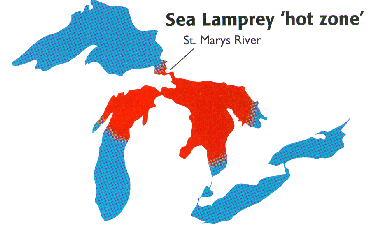| Sea Lampreys were first reported in Lake Ontario in 1835. After the canal was built, lampreys were discovered in Lake Erie in 1921, Lake Huron in 1932, Lake Michigan in 1936, and Lake Superior in 1946. The most populated region for lampreys in the Great Lakes is St. Mary's River, where the spawning of the adults occurs. The sea lamprey is considered an exotic species, and termed "biological pollutants." They are believed to be a major cause of loss of biodiversity in the Great Lakes. They have no natural predators or competitors in the habitat, and the native species of fish in the Great Lakes have adapted no protection to the exotic species. The red areas in the above picture are the regions highly populated with the sea lamprey. |


